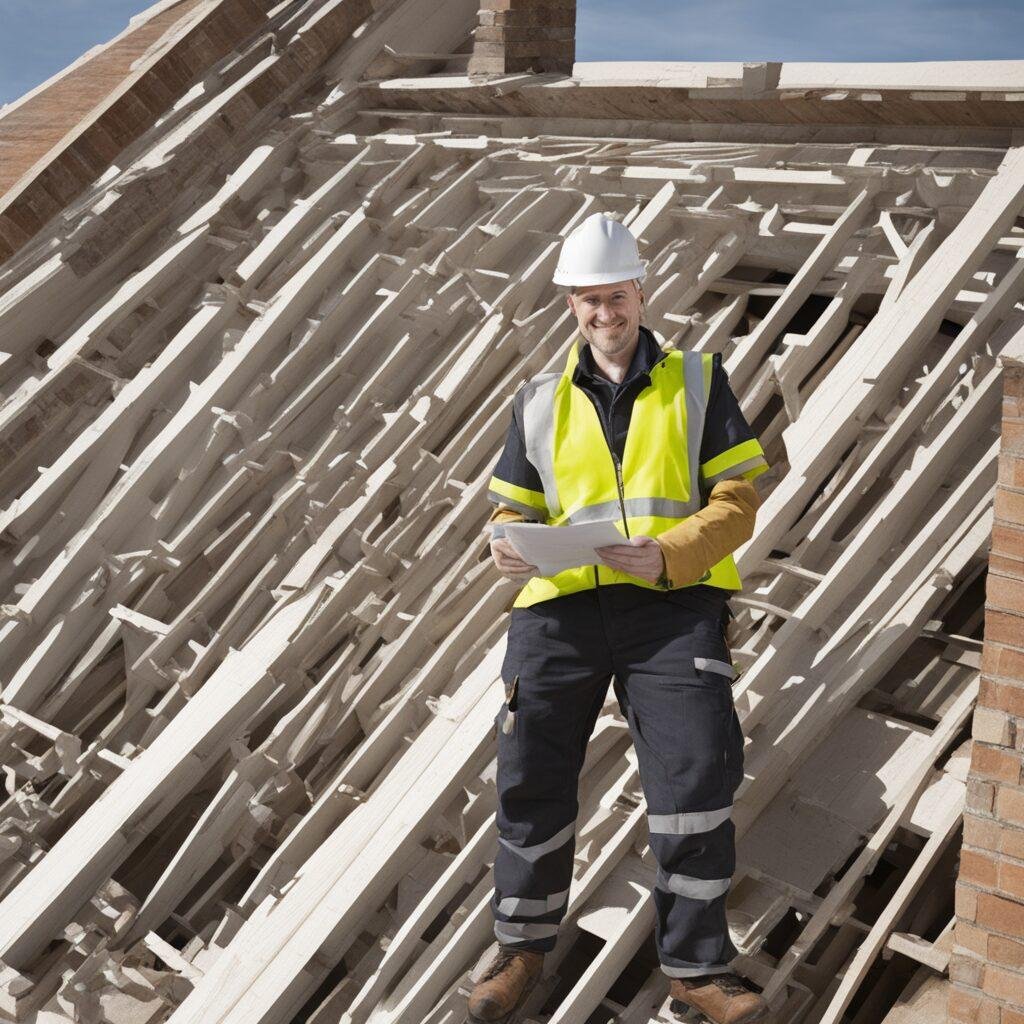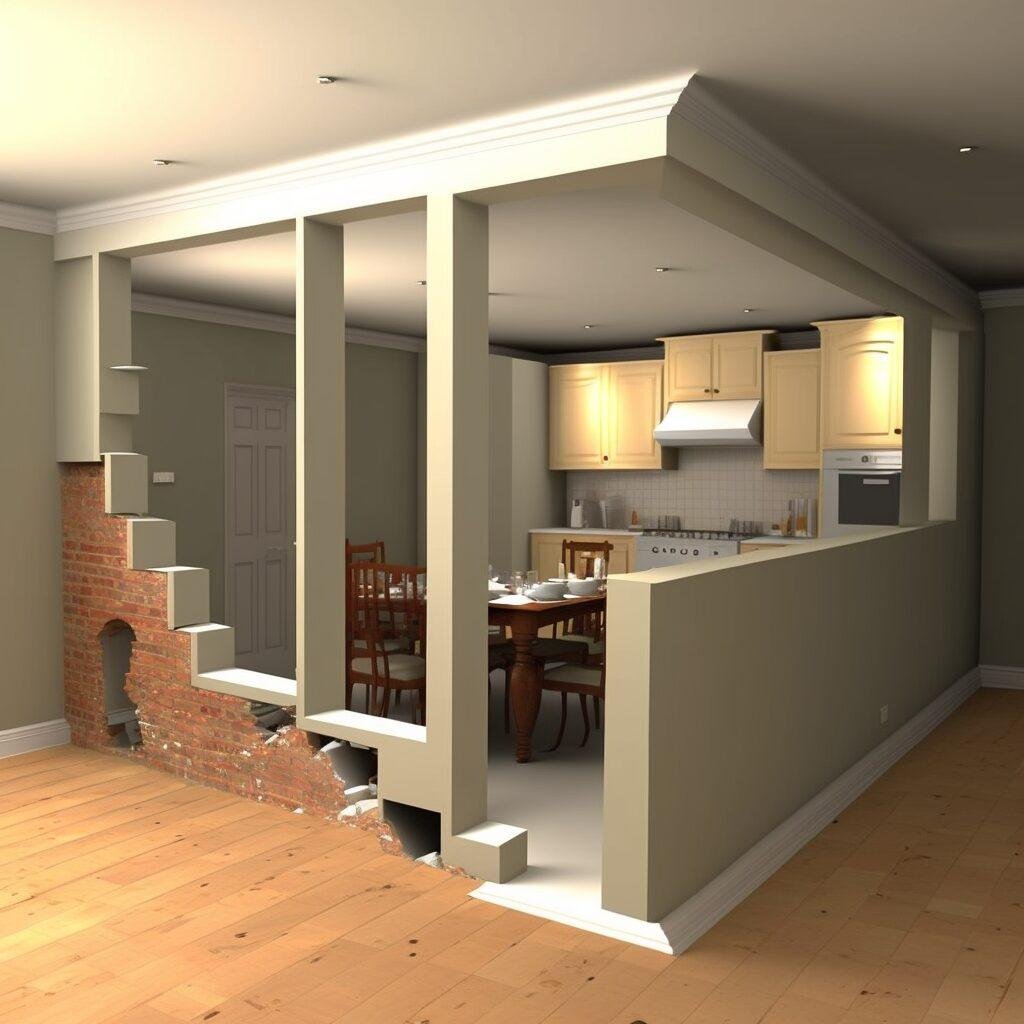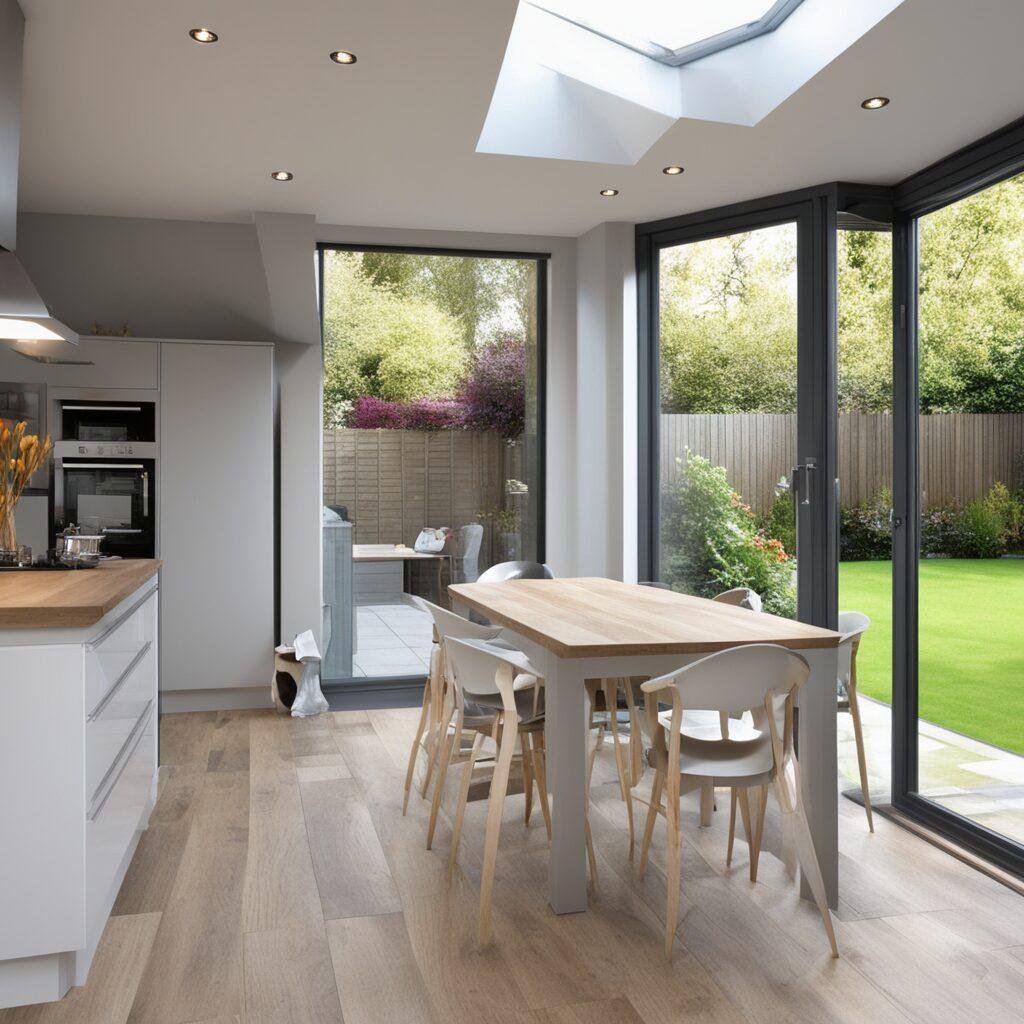Cost of Removing a Load Bearing Wall
Removing a load-bearing wall is a game-changer for any living space, and understanding the structural wall removal cost is essential for homeowners planning a home renovation for a more open layout. Surprisingly, this transformation is often not as pricey as you’d think and can be completed in just a few days. Such a change can significantly enhance your home’s layout, whether you’re aiming to create an open floor plan, add an extension, or merge two smaller rooms into one. It opens up numerous design possibilities. In this guide, we delve into the costs of removing an internal load-bearing wall and offer tips to keep your renovation budget-friendly.
Initial Cost Estimates


In the UK, the average cost of removing a load-bearing wall varies depending on the project’s scope. For a single doorway of about 1 meter, the average cost is typically around £1,100. For a double doorway that’s roughly 2 meters, the average is about £1,590. If you’re aiming for a large open space of about 4 meters, you can expect to pay around £2,750. Additionally, the material cost for a rolled steel joist (RSJ) per meter ranges from £145 to £325, averaging at £235. Concrete lintel beams cost between £8.0 and £170, with an average of £88.5. Steel lintel beams range from £10 to £750, averaging £390. For steel cavity lintel beams, the cost ranges from £35 to £650, with an average of £345.
Additional Costs and Professional Guidance


Cost Considerations for Structural Engineer
When assessing the cost of a structural engineer for load-bearing walls, it’s crucial to understand their role in the project. The structural engineer cost for a load-bearing wall is a key factor in the average cost of removing a load-bearing wall in the UK. Typically, this fee ranges from £1,250 to £1,750, reflecting the importance of their expertise in maintaining structural integrity during the removal process.
Labor Costs and Additional Expenses
The cost to remove a structural wall involves more than just the structural engineer’s fee. Labor costs, which usually fall between £400 and £800, are a significant part of the removing load-bearing wall cost. Additionally, the structural engineer may charge around £200-£300 for specialized services, contributing to the cost of removing a load-bearing wall.
Building Inspector's Approval and Associated Costs
In your budget for removing a load-bearing wall, don’t forget to include the potential costs for a building inspector’s approval. This approval is crucial to ensure compliance with local regulations, adding an extra £150-£200 to the average cost of removing a non-load bearing wall in the UK. This step is essential for both structural wall removal cost and cost to remove non-load bearing wall considerations.
Types of Interior Walls


There are primarily two kinds of walls inside a home: non-load bearing walls, often referred to as partition walls, and load-bearing walls, each with different implications for renovation. Partition walls are simpler to handle as they don’t bear any of the home’s weight. Removing these walls is generally a quicker and less costly process. However, when it comes to cost to remove a structural wall, particularly a load-bearing one, the scenario changes significantly. These walls are crucial for your home’s structural integrity. Removing a load-bearing wall requires careful planning and often involves higher costs due to the need for additional support structures like rolled steel joists (RSJs). This process involves detailed calculations to ensure the building’s safety and stability, reflecting the complexity and importance of such a project.
The Removal Process


Initial Assessment and Preparation
Before commencing any wall removal, it’s crucial to have the wall assessed by a builder or a structural engineer. They will inspect for electrical wiring, plumbing, and determine if the wall is load-bearing. Typically, this assessment costs around £200 per visit. Once you’ve decided to proceed, the first step is to clear the area of furniture and décor to prepare for the work ahead.
Setting Up for Removal
To minimize mess, setting up a dust screen is advisable as dust can spread extensively during the process. Next, ensure that all electrical connections are unplugged and items like radiators are removed. With the rooms cleared, the next step involves installing a temporary brace. This brace is crucial for supporting the masonry above during the removal process.
Removing the Wall
The actual removal begins with cutting an opening for the insertion of support stones and a beam, typically a rolled steel joist (RSJ). Depending on your design preference, the RSJ can be integrated into the ceiling for a seamless look or can be made a visible design element. Following this, the wall is carefully dismantled, and the temporary brace is removed.
Post-Removal Process
After the wall removal, you’re left with a new open space and the RSJ, which is then dry-packed and concealed as needed. The final steps involve clearing away all debris and thoroughly cleaning to remove any residual dust, leaving the area ready for the next phase of your renovation.
Factors Affecting Cost of Removing a Load Bearing Wall


The cost to remove a load-bearing wall varies based on the project’s size. For a single doorway about 1 meter wide, you’re looking at roughly £1,095. A double doorway, around 2 meters wide, will cost about £1,525. If you’re aiming for a more open space of about 4 meters, expect to pay around £2,700.
Additional Costs to Consider
While the main costs are significant, there are other expenses you should be aware of:
- Internal Renovation: If you’re thinking of doing more than just wall removal, like installing a stud wall or an RSJ, budget around £100-£150 per square meter.
- House Extension: Planning to extend your home? The cost can range from £15,000 to £125,000, depending on the size and materials.
- Painting and Decorating: After the wall is gone, you’ll likely need to touch up the decor. Professional painting or wallpapering costs between £180 and £500 per room.
- Plastering Work: Expect to pay £150-£250 per wall for plastering, especially where the removed wall used to be.
- New Flooring: Matching the flooring in the newly opened space could set you back £400-£1,000, depending on the room size and flooring type.
- Finishing Touches: Once the wall is out, you’ll have some odds and ends to sort out. This could include leveling the floor and ceiling, fixing sagging ceilings, or updating the flooring and decor. If you’re replacing a radiator, budget around £300, plus extra for new pipes. Moving light switches or outlets will cost you an additional £150 to £250.
Don’t forget the price of the support structures. Rolled steel joists (RSJs) usually cost about £232.50 per meter. For lintels, which support doors and windows, you’ll pay from £86.45 for concrete ones to between £342 and £370 for steel ones. Most quotes include waste removal, but if they don’t, you’ll need to budget an extra £200 for that.
Project Duration
Let’s talk about how long it usually takes to remove an inside wall. If it’s a load-bearing wall, you’ll start with a check-up from a structural engineer. This typically lasts just an hour or two. Taking down a wall isn’t a quick task. You’ll likely spend 1-2 days on it, and that includes putting in a rolled steel joist (RSJ). The time it takes can vary based on the wall’s length, its type, and how tough the job is.
After the wall is gone, you’ll need some plastering done in the room. How long that takes depends on the room’s size and how much plastering is needed. On average, though, expect to spend about 6-12 hours on the plastering.
Once you’ve got a handle on the time and costs, it’s essential to understand the legal requirements.
Legal Requirements


You don’t need planning permission to remove a wall unless you’re in a listed building. However, you might need a building notice from your local council or a private building control agency. This ensures you’re following all fire safety rules. Once the job’s done, it’s a good idea to get a completion certificate. This not only makes selling your home easier but also confirms that the work meets all standards. Expect to pay between £250 and £450 for the certificate.
If the wall you’re removing is next to a shared wall with a neighbor, you’ll need to put the rolled steel joist (RSJ) inside that wall. Since your neighbor owns part of that wall, you’ll need their okay to proceed. This means you’ll need a party wall agreement, which usually costs around £100. If your neighbor disagrees, the cost could skyrocket to over £1,000 as you’ll need structural engineers to sort it out. After the work, if your neighbor’s property is affected, you’ll have to cover the repair costs. Make sure to take pictures of both sides of the shared wall to avoid any future disputes.
Options for Wall Replacement
If you ever decide to switch things up or alter the room’s design, you can put up a stud partition wall where the load-bearing wall used to be. This is a budget-friendly option since the rolled steel joist (RSJ) is already handling the weight. To put a new load-bearing wall back will cost you about £100 to £150 per square meter. If you want to add a new door, that’ll be around £70.
Transforming a Victorian Terrace: Load-Bearing Wall Removal


Our structural engineering firm took on a project in a Victorian terrace house, aiming to create an open-plan living and dining area by removing a load-bearing wall.
Challenge:
The key challenge was safely removing a load-bearing wall that was integral to the structure of the two-story building.
Solution:
After a detailed structural assessment, we designed a custom steel beam (RSJ) support system. This solution was chosen for its strength and compatibility with the architectural style of the house.
Execution:
The project involved:
- Temporary propping of the upper floors.
- Demolition of the existing wall.
- Installation of the RSJ.
- Rerouting of electrical and plumbing services.
Cost Breakdown:
- Structural Engineer’s Assessment: £350
- Custom RSJ and Materials: £1,000
- Labor (including demolition and installation): £700
- Ancillary Costs (electrical and plumbing rerouting): £300
- Total Cost: £2,350
Outcome:
The removal of the load-bearing wall successfully created a spacious, open-plan area, blending modern functionality with the Victorian aesthetic.
Reflection:
This case study underscores the importance of expert structural engineering in modifying load-bearing elements, especially in historic properties. It also provides a transparent view of the costs involved in such a project.
Benefits of Removing a Wall


There are multiple benefits to taking down a wall in your house. Here are some key advantages:
- Additional Space: Knocking down a wall can really free up space. You could merge rooms to create a big, open area like a combo kitchen and dining room, or a living room and dining space. This gives you tons of new options for decorating and setting up furniture.
- Brighten the Space: Walls can cast shadows, making rooms feel gloomy. By opening up the space, you’ll let in more light and make the area feel more welcoming.
- Transform the Home: Removing walls can totally give new and improved appearance of your living space. Open floor plans are becoming the norm in
The Value of Wall Removal Projects


In summary, understanding the cost of removing a load-bearing wall is key to recognizing that this project is more than just a demolition job; it’s a significant investment in your home’s future. Whether you’re aiming to create an open floor plan or add an extension, the transformative potential is vast. It’s essential to consult with structural engineering experts and comply with legal requirements. With careful planning and budgeting, you can turn your living space into something truly extraordinary. Are you ready to knock down some walls and embrace new possibilities in your home?
FAQs on Wall Removal in Home Renovation
The cost to remove a non-load bearing wall typically falls within a more economical range, averaging between £700 and £1,500 per square meter in the UK. This reduction in cost reflects the less complex nature of the work involved compared to load-bearing wall removals. Additionally, preparatory tasks such as safeguarding the area and managing debris contribute an added expense, generally ranging from £250 to £550 per square meter.
This depends on the project’s complexity and the materials used. On average, in the UK, the cost can range from £1,200 to £2,500, depending on factors like wall size, the need for temporary support during removal, and the type of new support structure required.
Typically, when dealing with a load bearing wall, which plays a crucial role in supporting your building’s structure, enlisting a structural engineer’s expertise is advisable.
In the UK, the typical expense for dismantling a load-bearing wall ranges from approximately £1,500 to £3,800 per square meter. A significant portion of this cost is attributed to the services of a structural engineer, which can vary between £500 and £2,000, depending on the complexity and scale of the project.
Structural engineers identify load bearing walls by examining their orientation in relation to the joists. Walls running perpendicular to joists are typically load bearing. Although walls parallel to joists are generally not, exceptions exist, such as when a wall aligns with a joist or supports critical bracing elements.
While small scale residential projects may not legally mandate a structural engineer, their involvement becomes crucial for more complex or extensive construction endeavors. Local building regulations may also necessitate their consultation in specific scenarios.



- Head Office: Corwell Lane, Uxbridge, England, UB8 3DE.
- + (44) 07359 267907
- info@structuralengineercalcs.com


